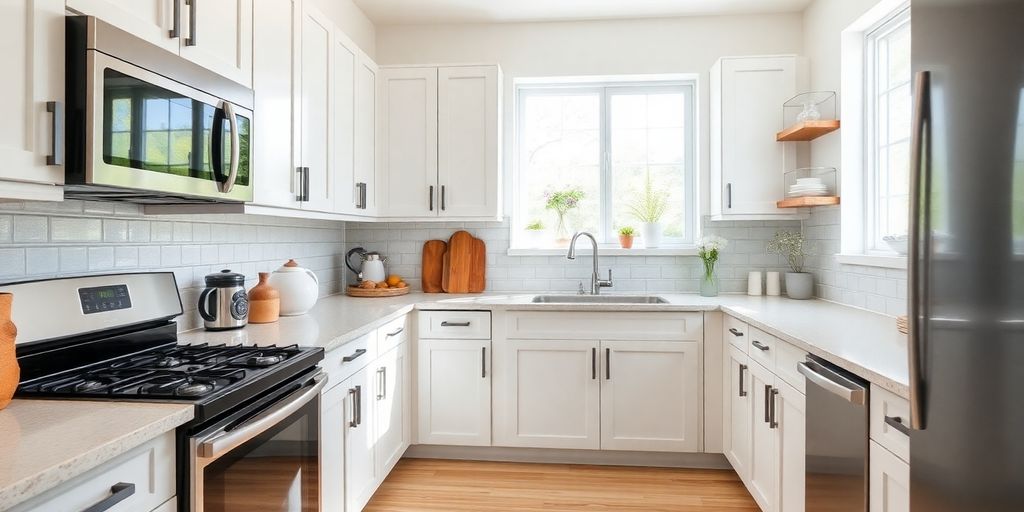Renovating your home can be a thrilling journey, but it can also turn into a financial headache if you’re not careful. Sticking to a home renovation budget is key to making sure your project doesn’t spiral out of control. We hope this run down will help you identify common pitfalls, give you practical planning tips, and explain how to keep your renovation costs in check.
Key Takeaways
- Be aware of common budget blowouts like unexpected structural problems and rising material costs.
- Create a detailed renovation plan that includes timelines and contingency funds.
- Always compare multiple quotes and understand what’s included before hiring a contractor.
- Clearly define your project scope to avoid changes that can lead to extra costs.
- Choose cost-effective materials and reliable suppliers to manage your budget effectively.
Identifying Common Budget Blowouts
Renovating your home can be an exciting journey, but it’s also one where costs can quickly spiral out of control if you’re not careful. Understanding where these common renovation cost blowouts and how to avoid them occur is the first step in keeping your project on track. Let’s look at some typical pitfalls.
Unexpected Structural Issues
One of the biggest budget killers is uncovering hidden problems once you start demolition. What looks like a simple wall removal might reveal termite damage, asbestos, or outdated wiring that needs immediate attention. These issues weren’t visible during the initial inspection and can add significant costs to your project. It’s always a good idea to factor in a buffer for the unexpected.
Rising Material Costs
Material prices can fluctuate, especially with global events impacting supply chains. What you budgeted for tiles or timber last month might be significantly more expensive today. Keep an eye on market trends and try to lock in prices with suppliers where possible.
Changes in Project Scope
Scope creep is a sneaky budget buster. It starts with a small change – “While we’re at it, let’s just move that powerpoint” – but these little additions add up. Before you know it, you’re doing a whole new project. It’s important to define your scope clearly from the start and stick to it as much as possible. If you do decide to make changes, get a revised quote in writing before proceeding. This will help you understand the cost implications and avoid nasty surprises later on. Remember, transforming laundry rooms can be a great way to add value to your home, but only if you manage the budget effectively.
It’s crucial to have a contingency plan. Aim for at least 10-15% of your total budget to cover unforeseen issues. This will provide a financial cushion and peace of mind throughout the renovation process. Also, choosing the right trades to stay on budget is important, so do your research.
Effective Planning Strategies
So, you’re ready to tackle that reno? Awesome! But before you start swinging a hammer, let’s talk planning. Good planning isn’t just about making things look pretty; it’s about keeping your sanity (and your wallet) intact. Trust me, a little prep work goes a long way in avoiding those nasty budget surprises. It’s about creating a home renovation guide that works for you.
Creating a Detailed Renovation Plan
Think of this as your renovation roadmap. What exactly do you want to achieve? What rooms are getting a facelift? What’s staying put? Get specific. Write it all down. Even better, sketch it out. Those initial design sketches are invaluable.
- List every single task, no matter how small.
- Gather inspiration from magazines, websites, and display homes.
- Consider the flow of your home and how the renovation will impact it.
A detailed plan isn’t just a list of tasks; it’s a living document that you’ll refer to throughout the renovation. It helps you stay focused, make informed decisions, and communicate effectively with your tradies.
Setting Realistic Timelines
Okay, this is where things can get tricky. We all want our renovations done yesterday, but reality often has other plans. Be honest with yourself about how long things will actually take. Chat with your contractors, get their input, and then add a buffer. Things always take longer than expected.
- Factor in lead times for materials (especially if you’re ordering anything custom).
- Consider potential delays due to weather or unforeseen issues.
- Break down the project into smaller, manageable phases with individual deadlines.
Incorporating Contingency Funds
This is non-negotiable. Seriously. No matter how well you plan, something will go wrong. A pipe will burst, you’ll discover asbestos, or you’ll simply change your mind about something. A contingency fund is your safety net. Aim for at least 10-15% of your total budget. Think of it as your ‘oops’ money. It’s there for those unexpected structural issues that always seem to pop up. It’s better to have it and not need it than to need it and not have it. It’s all about effective project management.
Understanding Quotes and Estimates
Getting your head around quotes and estimates is super important to keep your reno on track. It’s where the rubber hits the road in terms of budgeting. Let’s break down how to make sense of it all.
Comparing Multiple Quotes
Don’t just jump at the first quote you get! Getting several quotes is essential. Aim for at least three, but more is better. Why? Because it gives you a good range of what different tradies think the job will cost. Look beyond just the bottom line. What’s included? What’s not? Are the materials similar quality? A super cheap quote might mean corners are being cut, and that can cost you more in the long run. It’s like when you’re trying to find the best renovation loan options – you wouldn’t settle for the first one you see, would you?
Understanding Inclusions and Exclusions
This is where things can get tricky. A quote should clearly spell out exactly what’s included. Does it cover the cost of materials? What about labour? What about site cleanup? Are there any potential extra costs that aren’t included? For example, does the quote include the cost of removing asbestos if it’s found? Or is that an extra? Make sure you understand what you’re paying for, and more importantly, what you’re not paying for. Read the fine print, and don’t be afraid to ask questions. If something isn’t clear, get it clarified in writing.
Negotiating with Contractors
Negotiating isn’t about trying to rip someone off. It’s about getting a fair price for a fair job. Once you’ve got a few quotes, you can use them as leverage. If one quote is significantly higher than the others, ask the contractor why. Maybe they’re using higher quality materials, or maybe they’ve just padded the price. Be polite, but firm. See if they’re willing to budge. You might be surprised at how much you can save just by asking. Remember, a good contractor wants your business, and they’re often willing to negotiate to get it. Just make sure you’re comparing apples with apples – don’t sacrifice quality just to save a few bucks. Here’s a few things to keep in mind:
- Be clear about your budget.
- Know what you’re willing to compromise on.
- Get everything in writing.
It’s important to remember that the cheapest quote isn’t always the best. Consider the contractor’s experience, reputation, and communication skills. A slightly more expensive contractor who’s reliable and easy to work with can save you a lot of headaches in the long run.
Defining Clear Scope and Design Decisions
It’s easy for renovation budgets to spiral out of control when the scope isn’t clearly defined from the start. Vague ideas and changing your mind mid-project are budget killers. Let’s look at how to avoid these pitfalls.
Establishing Priorities
Before you even think about paint colours or tile patterns, sit down and work out what’s most important to you in this renovation. What are your must-haves, and what are the nice-to-haves? This helps you allocate your budget effectively. For example, if you’re renovating a bathroom, is a luxury bathroom renovation a priority, or are you happy with something more functional? Knowing this upfront will guide all your decisions.
Consider these questions:
- What problems are you trying to solve with this renovation?
- What are your absolute must-have features?
- What are you willing to compromise on if needed?
Finalising Design Choices
Once you’ve established your priorities, it’s time to nail down the design. This means choosing your materials, fixtures, and finishes. The more specific you are, the more accurate your quotes will be. Avoid making changes once the project is underway, as this can lead to delays and extra costs. Get those initial house sketches done!
A well-defined design is your roadmap to a successful and on-budget renovation. It minimises surprises and ensures everyone is on the same page.
Avoiding Last-Minute Changes
This is where many renovations go off the rails. It’s tempting to change your mind about something halfway through, but even small changes can have a big impact on your budget. For example, swapping out tiles after they’ve already been ordered can incur restocking fees and delays. Try to resist the urge to make changes unless absolutely necessary. If a change is unavoidable, get a written quote for the additional cost before proceeding. Consider the impact on the overall timeline too. It’s better to stick to your plan and avoid those nasty surprises. If you are dealing with structural renovation, it is always best to hire a team that will get the job done with caution.
Budgeting for Materials and Labour

Choosing Cost-Effective Materials
When it comes to budget planning renovations, the materials you choose can significantly impact your overall costs. It’s tempting to go for the highest-end options, but there are often more affordable alternatives that still look great and perform well. Think about exploring different suppliers and comparing prices. Consider things like:
- Flooring: Instead of hardwood, look at laminate or vinyl plank flooring. They can mimic the look of wood at a fraction of the cost.
- Tiles: Ceramic tiles are generally cheaper than porcelain or natural stone. Explore different patterns and sizes to find something that fits your style and budget.
- Fixtures: Shop around for sales and discounts on taps, showerheads, and other fixtures. You might be surprised at the deals you can find.
Estimating Labour Costs
Labour is a big part of any renovation budget, so it’s important to get accurate estimates. Get quotes from multiple tradies and make sure they break down the costs clearly. Ask about their hourly rates, any call-out fees, and what’s included in their price. Don’t just go for the cheapest quote – consider their experience, reputation, and whether they’re licenced and insured.
Finding Reliable Suppliers
Finding reliable suppliers is key to staying on budget and getting quality materials. Ask your tradies for recommendations, or do your own research online. Look for suppliers that offer competitive prices, good customer service, and a wide range of products. It’s also worth checking if they offer any discounts for bulk purchases or trade customers.
It’s always a good idea to build a buffer into your budget for unexpected costs. Aim to set aside around 10-15% of your total budget as a contingency fund. This will help you cover any surprises that might pop up along the way, such as needing to renovate a bathroom in Kingsley, without derailing your entire project.
Working with Reputable Renovation Companies
Choosing the right renovation company can make or break your project. It’s not just about getting the job done; it’s about peace of mind, quality workmanship, and staying on budget. So, how do you find a good one? Let’s break it down.
Researching Company Credentials
First things first, do your homework. Don’t just jump at the first quote you get. Check if the company is licenced and insured. In Australia, licencing requirements vary by state, so make sure they’re compliant in your area. Insurance is essential – it protects you if something goes wrong on site. Ask for their licence and insurance details and verify them independently. A reputable company will be upfront and happy to provide this information. Also, how long have they been in business? Longevity often indicates stability and experience. This is a key step in any cost-effective home renovation.
Reading Customer Reviews
Online reviews are your friend. Check sites like Google Reviews, Facebook, and independent review platforms. Look for patterns – are there consistent complaints about communication, quality, or hidden costs? Pay attention to how the company responds to negative reviews. Do they address concerns professionally and try to resolve issues? A few bad reviews aren’t necessarily a deal-breaker, but a pattern of negativity should raise red flags. Don’t rely solely on the company’s website for testimonials; seek out unbiased opinions.
Establishing Clear Communication
Communication is key to a successful renovation. From the initial consultation to the final walkthrough, you need to be able to communicate effectively with your renovation team. Before you sign any contracts, assess how well the company communicates. Are they responsive to your questions? Do they explain things clearly and in a way you understand? Do they provide regular updates on the project’s progress? A good renovation company will prioritise clear and open communication, ensuring you’re always in the loop. This is especially important for budget-friendly home improvements.
A written contract is non-negotiable. It should outline the scope of work, materials to be used, payment schedule, and a clear timeline. Don’t be afraid to ask questions and clarify any points you’re unsure about before signing. This document is your protection, so make sure it’s comprehensive and accurate.
Finding reliable suppliers is also important for cost-effective renovation tips.
Monitoring Your Renovation Progress

Staying on top of your renovation is crucial for keeping your budget in check. It’s easy for costs to spiral if you’re not paying attention. Regular monitoring helps you catch potential problems early and make informed decisions. This is where renovation cost planning really pays off.
Regular Check-Ins with Contractors
Communication is key! Schedule regular meetings with your contractors. This doesn’t have to be a formal sit-down every week, but consistent updates are essential. Ask questions like:
- Is the project on schedule?
- Are there any unexpected issues?
- Are there any potential cost overruns?
Don’t be afraid to ask for clarification on anything you don’t understand. A good contractor will be happy to explain things in plain English. These check-ins are a great way to implement home renovations and ensure everything is going to plan.
Tracking Expenses
Keep a detailed record of every expense, no matter how small. Use a spreadsheet, budgeting app, or even a notebook – whatever works for you. Categorise your spending (materials, labour, permits, etc.) to see where your money is going. This is a key part of financial planning for renovations.
Here’s a simple example of how you might track expenses:
| Item | Cost | Category |
| Tiles | $500 | Materials |
| Plumber | $300 | Labour |
| Paint | $100 | Materials |
It’s easy to lose track of small purchases, but they add up quickly. Make sure you’re recording everything, even that extra trip to Bunnings for screws.
Adjusting the Budget as Needed
Even with the best planning, unexpected costs can arise. If you encounter a budget blowout, don’t panic. Review your priorities and see where you can make adjustments. Can you choose a less expensive tile? Can you DIY some of the painting? This is where those Renovation budgeting tips come in handy.
Consider these options:
- Re-evaluate material choices.
- Postpone non-essential upgrades.
- Negotiate with contractors.
Remember, the goal is to complete your renovation without breaking the bank. Being proactive and adaptable will help you achieve a successful home makeover on a budget.
Keeping track of your renovation is really important. You should regularly check how things are going to make sure everything is on schedule and within budget. Take photos, write notes, and talk to your builders often. If you want more tips on how to manage your renovation, visit our website for helpful advice!
Wrapping Up Your Renovation Journey
So, there you have it. Keeping your renovation on budget doesn’t have to be a headache. Start with a solid plan, get a few quotes, and don’t forget to set aside some cash for those unexpected hiccups. Clear design choices and sticking to your scope can save you a lot of stress down the line. And remember, working with a trusted renovation company can make all the difference. They’ll help you navigate the tricky bits and keep everything on track. With a bit of preparation and the right team, you’ll be well on your way to creating the home of your dreams without breaking the bank.
Frequently Asked Questions
What are common reasons for going over budget during renovations?
Some usual reasons include unexpected problems with the building, rising costs of materials, and changing what you want to do during the project.
How can I plan my renovation to stay within budget?
Make a detailed plan, set realistic timelines, and include extra money for surprises.
What should I know about getting quotes from contractors?
It’s smart to compare different quotes, check what is included or not, and try to negotiate the price.
How can I keep my renovation focused on what I really want?
Decide on your top priorities, finalise your design choices early, and try to avoid making changes at the last minute.
What tips do you have for budgeting materials and labour?
Choose materials that are good quality but not too expensive, estimate how much you’ll pay for labour, and find trustworthy suppliers.
Why is it important to work with a good renovation company?
A reputable company will have the right skills, good reviews, and clear communication, which helps your project go smoothly.

